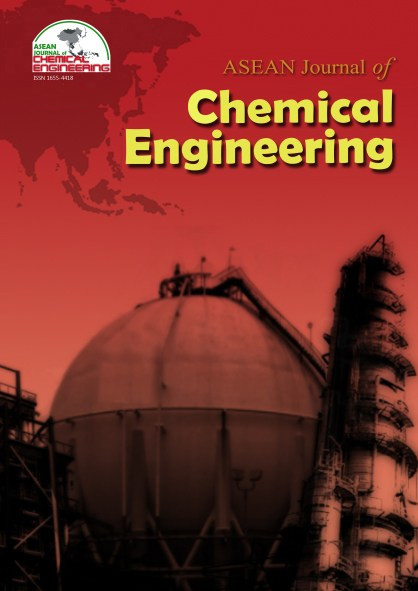Catalytic Decarboxylation of Palm Oil to Green Diesel over Pellets of Ni-CaO/Activated Carbon (AC) Catalyst Under Subcritical Water
Abstract
There has been a considerable in converting palm oil to green diesel. Green diesel is a hydrocarbon compound similar to conventional diesel fuel's components. It is expected to substitute conventional diesel fuel in diesel vehicle engines. The process of producing diesel is also called the deoxygenation process. One of the deoxygenation processes is decarboxylation. The current study evaluates the performance of Ni-CaO/AC catalyst in the form of pellets by mixing a powder Ni-CaO/AC catalyst and phenolic resin. The aim of this study namely to evaluate the performance pellets of Ni-CaO/AC catalyst in the decarboxylation of palm oil under sub-critical water. This research includes catalyst activity carried out by decarboxylation in subcritical water with temperature variations: 300, 310, 320, and 330 °C using pellets of Ni-CaO/AC catalyst. The decarboxylation products obtained were analyzed with Gas Chromatography-Mass Spectroscopy (GC-MS). The results obtained in this study showed that the highest percentage composition and selectivity of green diesel were obtained at a temperature of 330 °C, with values of 18.08 and 22.07, respectively. These results suggest that higher temperature promotes the hydrogenation-decarboxylation reaction of palm oil. Pellets of Ni-CaO/AC catalyst can increase the selectivity of green diesel if the phenolic resin is replaced with a binder that can provide physical strength to the catalyst but does not damage the function and cover much of the active surface area of the catalyst. We can conclude that pellets of Ni-CaO/AC catalysts have the potential to do hydrothermal decarboxylation if the increased operating condition.
References
Al Alwan, Basem A. Al., 2014. Biofuels Production via Catalytic Hydrocracking of Dogs Corn Oil and Hydrothermal Decarboxylation of Oleic Acid Over Transition Metal Carbides Supported on Al-SBA-15. the Graduate School of Wayne State University, Detroit
Asikin-Mijan, N., Lee H.V, Juan J.C., Noorsaadah A.R., and Taufiq-Yap Y.H., 2017. “Catalytic deoxygenation of triglycerides to green diesel over modified CaO-based catalyst”, RSC Adv., 7, 46445.
Fogler H.S., 2016. Elements of Chemical Reaction Engineering, Fifth Edition, Pearson Education, United States
Hossain, Z., 2017. Hydrothermal Decarboxylation of Fatty Acids and Their Derivatives for Liquid Transportation Fuels. PhD Thesis. Chemical and Biochemical Engineering, The University of Western Ontario
Hossain, Z., Jhawar, A.K., Chowdhury, M.B.I, W.Z., Wu, W., Hiscott, D. V., and Charpentier, P. A., 2017. “Using subcritical water for decarboxylation of oleic acid into fuel-range hydrocarbons.” Energy and Fuels, 31(4), 4013–4023.
Jin, M. and Choi, M., 2019. "Hydrothermal deoxygenation of triglycerides over carbon-supported bimetallic PtRe Catalysts without an external hydrogen source." Molecular Catalysis, 474, 110419.
Krobkrong, N., Itthibenchapong, V., Khongpracha, P., and Faungnawakij, K., 2018. “Deoxygenation of oleic acid under an inert atmosphere using molybdenum oxide-based catalysts.” Energy Conversion and Management, 167, 1–8.
Kruse, A. and Dahmen, N., 2015. "Water - a magic solvent for biomass conversion." J. Supercrit. Fluid., 96, 36–45.
Miao, C.. , Marin-Flores, O., Dong, T., Gao D., Wang Y., Garzia-Perez, M., Chen, S.. 2018. “Hydrothermal catalytic deoxygenation of fatty acid and bio-oil with in situ H2.” ACS Sustainable Chemistry and Engineering, 6(4), 4521–4530
Rosalina, L., 2012. “Preparation and Characterization of NiMo/Al2O3 Nanoparticle Catalyst Using Simple Heating Method for Renewable Diesel Synthesis.” Bachelor Thesis, Universitas Indonesia.
Septriana, D., Azis, M.M., and Wintoko, J., 2021. “Synthesis of Ni-CaO/Activated Carbon (AC) catalyst for cooking oil conversion to green diesel.” The 13th AUN/SEED-Net Regional Conference on Chemical Engineering 2020 (RCChE-2020), Institute of Technology of Cambodia, Phnom Penh, Cambodia
Zhang, J., Huo, X., Li, Y. and Strathmann, T.J., 2019. “Catalytic hydrothermal decarboxylation and cracking of fatty acids and lipids over Ru/C.” ACS Sustainable Chemistry and Engineering, 7(17), 14400–14410.
Copyright holder for articles is ASEAN Journal of Chemical Engineering. Articles published in ASEAN J. Chem. Eng. are distributed under a Creative Commons Attribution-NonCommercial 4.0 International (CC BY-NC 4.0) license.
Authors agree to transfer all copyright rights in and to the above work to the ASEAN Journal of Chemical Engineering Editorial Board so that the Editorial Board shall have the right to publish the work for non-profit use in any media or form. In return, authors retain: (1) all proprietary rights other than copyright; (2) re-use of all or part of the above paper in their other work; (3) right to reproduce or authorize others to reproduce the above paper for authors’ personal use or for company use if the source and the journal copyright notice is indicated, and if the reproduction is not made for the purpose of sale.



